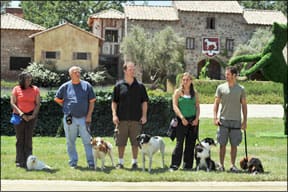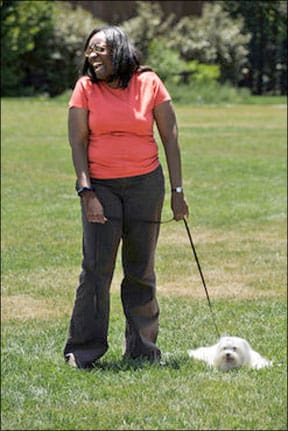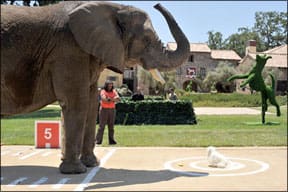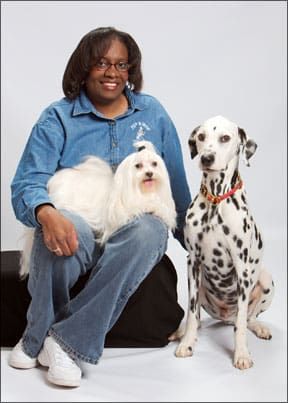How many of you would put your dog and yourself at the mercy of a network TV “reality” show, competing against other dogs and dog owners for more than six weeks? Keep in mind that the show’s producers will do their best to foment discomfort and personal conflict between yourself and your fellow contestants. Also, while your every moment will be filmed, only a highly edited and manipulated version of what actually happened will be broadcast to a national audience, who will be encouraged to share their opinions with other dog owners about you, your dog, your dog training skills, and your most unguarded facial expressions and utterances. I don’t think I would do it!
In my opinion, all of the 12 people who actually put themselves through this very experience last spring and summer on CBS’s “Greatest American Dog,” were very brave. True, they were competing for a prize of $250,000, and some hoped to use the exposure to promote their various careers; there was potential for some compensation to offset the risk of being made to look ridiculous.
In my opinion, though, the most admirable contestant was Laurie Williams, CPDT, a professional dog trainer from Fredericksburg, Virginia, who went on the show with her six-year-old Maltese, Andrew.
During the final episode, broadcast on September 11, the judges questioned the final three contestants about their motivation for taking part in the competition and what they had gotten out of the experience. Williams answered that her motivations for being on the show included promoting positive, dog-friendly training, and showing what well-trained small dogs are capable of. She added that she felt that she and Andrew had succeeded in realizing those goals.
The three judges on the show agreed. “Laurie, you and Andrew have so much love and respect for each other. You define what dog ownership is all about,” said judge Victoria Stilwell. Another judge, Allan Reznik, commented, “Andrew loves to work. I’ve never seen a dog work so happily, and that joy reflects the loving nature of your relationship and of your work ethic.” The final judge on the show, Wendy Diamond, said, “Andrew is the most incredible Maltese we have ever witnessed.”
Despite these enthusiasms, the judges selected another dog/owner pair as the winners of the “Greatest American Dog” title; Williams finished the competition in second place. Williams remains proud of her accomplishments on the show. “We definitely walked out of there with our heads held very high,” she says.
I interviewed Williams shortly after the conclusion of the show, to talk about her experiences in the competition, the opportunity she had to demonstrate dog-friendly training to a mass audience, and about her professional observations about the advantages of positive-only dog training techniques. You don’t have to have seen the show to appreciate her comments about the benefits of a strong, fear-free relationship with your dog.
WDJ: Laurie, it’s great to talk to you! Please accept my congratulations and condolences on your second-place finish. Of course, I wanted you to win!
LW: Thank you. I did, too!
WDJ: You got as close to winning as possible. Unfortunately, there was no way of guessing which way the final judging was going to go. It wasn’t at all clear what the judges criteria were.
LW: Yes, that was disappointing. But I’m very proud of Andrew. He did everything I asked him to do and more. And I’ve received hundreds of letters and e-mails from people who appreciated his performance.
WDJ: During the show’s run, I was unsure as to whether you or any of the other contestants were professional trainers. The biography provided by the show indicated you were a dog daycare owner.
LW: I’m not sure why they did that. I am a dog daycare owner, but I’m also a Certified Pet Dog Trainer (CPDT). I opened my business, Pup N Iron, in Fredericksburg, Virginia, in 2005. It is primarily a training facility and dog daycare, but we also have a therapy pool and offer rehab. I used to be a personal fitness trainer and a gym manager, and I would always joke around with my colleagues that one day I was going to open a dog gym and call it Pup N Iron. They would all laugh at me, but I got the last laugh, because I have realized my dream.
WDJ: Were you the only professional trainer on the show?
LW: I wasn’t. Teresa Hanula is also a CPDT, although the show identified her only as a pet sitter. She has a dog training and a pet-sitting business. Two of the other five finalists, Bill McFarlin and J.D. Platt, also have extensive dog training experience.
WDJ: Which makes it even more strange that the winner, Travis Brorsen, was quite up-front in saying he had no dog training experience whatsoever.
LW: He did make a lot of progress over the course of the show, though. He was smart enough to spend a lot of time learning from those of us who had a lot of experience, and asking a lot of questions. And he really did have a nice relationship with his dog. Plus, they were very appealing; they had “that look,” the stereotypical all-American boy from the Midwest and his floppy-eared young Boxer.
WDJ: I had a bad feeling about the show from the way it was originally described, but as a viewer, I was drawn in from the beginning. I have to say, though, that I was frustrated throughout the series because the technical aspects of training were very rarely discussed. And only in the final episode did we hear anyone say, “positive, dog-friendly training.” I could have kissed the TV when I heard you use that phrase.
LW: It was even more frustrating for me, because getting those words on TV was definitely part of my whole agenda for being on the show. I told [the producers] going in that that’s what I wanted to show. I wanted to show them the fantastic relationship I have with my dog, which was created entirely through positive training.
WDJ: I was surprised by the selection of the participants on the show. It seemed as though the producers wanted some well-trained dogs, but not all well-trained dogs on the show.
LW: That surprised me, too. From the way the concept of the show was described to me, I thought it was going to focus on the relationships between dogs and owners and that the whole objective was to test who had the strongest and best relationship. I wasn’t envisioning a lot of physical challenges; I thought it would be more about having a well-behaved dog and one you’re in sync with. That’s one of the reasons I was shocked when I saw very young dogs and completely untrained dogs after the selections were made.

At the end, the judges talked about who was the most improved. I thought, Gee, I wish I knew at the beginning they wanted to see the dog’s progression. I also have a young Dalmatian I could have brought if that’s what they wanted! But, in retrospect, I brought exactly the right dog, maybe not to “win” by the judges’ standard, but to be a champion for my cause. I’m getting lots of e-mails from people who really appreciated what Andrew and I have, and who recognized the depth of our relationship.
WDJ: Did the show’s producers provide any instruction to those who needed help getting their dogs to complete the challenges?
LW: They did have trainers studio trainers who do things completely differently from the way I do them. Generally, they didn’t seem concerned with how to teach a dog to do something in a way that preserves his relationship with them, or in a way that will prove to be a positive experience for the dog in the long run. Studio trainers just want to get the dog to “get the shot” as fast as possible. Learning theory and principles of animal behavior was not the focal point.
Also, some of the participants were advised to get some help with training their dogs before the show started. The producers even sent lists of trainers to the contestants with a suggestion that we have some dog training “cram sessions” before we got to the show. I know that Travis (the eventual winner of the show) was one of the people who spent a bunch of time with a dog trainer, a week or two before the show started filming.
Here’s an odd thing: They made it clear from the beginning that all training styles would be welcome. And not all of the trainers on their list were positive trainers.
But when we got there, and learned that Victoria Stilwell [a positive trainer from Britain, and star of a cable TV show called It’s Me or the Dog!] was one of the judges, it was clear that at least some of the judging would be biased toward positive techniques. Which was fine with me; I’m completely committed to positive training. It was not especially fair to the people who use other types of training methods. J.D., in particular, got a raw deal; even though nobody ever saw him do anything harsh to his dog, Galaxy, he frequently described himself as an “old-school dog trainer,” and he got slammed for that on the show. If that’s not a set-up, I don’t know what is.
WDJ: I wanted to ask you about J.D. and his dog. It seems to me that you have a very strong relationship with Andrew, and clearly, nothing makes him happier than to work with you. J.D. also seems to have a strong relationship with Galaxy but I thought I could see a difference between the bond between you and Andrew and the one between J.D. and Galaxy. She’s a very well-trained dog, but there were moments when her body language told me that she had some reservations about him, that she had been trained with force-based methods at some point. It sometimes seemed as if she complied with his requests because she was at least conscious of the potential for an unpleasant consequence.
The judges said several times that Galaxy seemed “robot-like.” I think they were responding to the same things I was seeing but I have had a hard time figuring out what, exactly, it was about her that lent these impressions. I mean, it’s not like she cowered from him or anything like that. I finally decided that it’s her stillness, that body language that says, “Maybe I had better sit here and think about what he wants me to do, so I don’t make a mistake.” Whereas dogs who have been trained with no aversive techniques frequently and spontaneously “offer” behaviors. Was it a lack of exuberance?
LW: Perhaps that’s it the lack of that glee, that joy, that “Hey! Let me try this!” But you know, she’s also an older dog. She was very quiet. She didn’t really come alive until he got the ball out and she could work.
Andrew, on the other hand, did do that. He chose to do his own thing a lot. That was one thing that kind of got my goat, when the judges suggested he had separation anxiety. I felt that was so irresponsible of them to equate what can be such a serious dog behavior issue to Andrew’s desire to remain with me when given the choice. I’ve worked hard to establish that connection with him, because it’s necessary with a therapy, service, and performance dog.

Once he jumped up on an obedience trial judge in the ring “Hi judge! Pick me up!” He’s also prone to veering off to greet people at ringside , “Hello fans, love you!” He’s really a ham. And he offers behaviors all the time; he’s always clowning. In contrast, Galaxy is very “locked on,” very quiet, and I never really saw her behave in an upbeat way until her ball came out. But you’re right; she doesn’t offer behavior. She rarely did anything until told to do so.
WDJ: J.D. was highly criticized by the judges during the so-called “loyalty challenge,” where the dogs had to stay even with people using toys and food to try to get them to break the stay. She was really tempted by the balls and other toys and food, and he had to lean forward and raise his voice and his intensity, and keep repeating, “Galaxy, no, no!” and “Stay!” You and Andrew provided quite a contrast there. You were very quiet and calm, not at all intense, and you only had to repeat “Andrew, stay!” I loved watching that.
LW: That challenge was really difficult for Galaxy because she really loves to chase balls and to eat treats, since she never gets them! J.D. doesn’t believe in using food in training at all, and never, ever gives dogs “people food,” so of course food was her weakness, her Achilles heel. That’s why he felt he had to stay on her like that, kind of stay in her face, take his intensity to that level.
But that challenge leveled the playing field in that it was all about our relationships with our dogs and how we communicate with them; finally the dog’s size or age or physical condition didn’t matter. I mean, a dog can only do what he can do physically. Physically, Andrew cant do everything that Travis Boxer can do. The challenges like that, which tested our relationships, were my favorites. And that one in particular showed how strong the relationship is between Andrew and me. Hed rather hang out with me than go play ball or take food from someone else, and thank God for that!
Another reason I liked that one: It did really show your training style. If I leaned over Andrew and shook my finger at him and raised my voice, he wouldn’t know what that means. He’d be curious; “What are you doing, Mommy?”
I was trying to explain this to J.D.; he didn’t understand why the judges said he was being intimidating to Galaxy, because of course he didn’t hit her or scare her. I told him that it seemed like he was telling Galaxy, “Don’t you move, or else!” For my dog, there has never been an “or else.” Andrew doesn’t know what “or else” might mean. The worst thing that might happen is that I pick him up and put him back in that spot and ask him to do it over again. And the more likely thing that may happen is that he’ll get some delicious treats after a while.
But, again, J.D. wasn’t the only one who used that posture. I think most of the other contestants except for me used that type of body language at some time or another.
WDJ: Andrew was the only purely positively trained dog on the show, then?
LW: By my definition of correctly implemented positive training methods, yes. However, I think some of the contestants really didn’t know what correct positive training is. Some thought they were using positive methods when they actually were bribing and baiting, never “marking” correct behavior and just babbling “Sit! Sit! Sit! Sit!” Repeating every cue half a dozen times. That’s what gives people like J.D. a negative view of positive training
WDJ: This is what I liked most about the show: The opportunity to watch different people work with their dogs, and see what works well and what doesn’t. I can see the difference between dogs who are trained with only positive techniques, dogs who are trained with a lot of aversives, and dogs who are trained with a mix of techniques. Except for Andrew, the dogs on the show seemed like mostly the latter. J.D. and Galaxy, included.

LW: I found J.D. to be a very gifted handler, but from my view, he didn’t understand the science of animal behavior. He would say, “I never use treats; I’m old school!” And I would say, “J.D., don’t you understand that when you use playing with a ball as a reward, or praising Galaxy with words and petting, you are using positive reinforcement, just like I’m doing with my treats?” He couldn’t wrap his brain around that. He thought it was different. I would say, It doesn’t matter what the reward is, as long as the dog enjoys it. He could not accept that.
WDJ: Teresa and Leroy might be another example. It was clear that she used positive training and had taught him to do a lot of things but there were times when he would get overstimulated and lose focus, and she would get frustrated and yell at him. He would get confused and anxious and start barking . . .
LW: I have gotten to know Teresa better since the show ended, and I know she’s very committed to positive training. Some of her problems with Leroy are kind of like stage mother problems. I think she gets self-conscious and anxious when there are people waiting for her to get Leroy to do something, and she gets nervous, and he feels that and gets more nervous. But she’s very well-educated about animal behavior. And when she’s teaching others what to do with their dogs, she’s very positive, very patient, very encouraging.
WDJ: It must be difficult to sit still when you hear or read criticism from people who saw the show, knowing that they were only seeing an edited version of what really happened.
LW: Well, yes. And many people just dismissed the show out of turn, because it seemed ridiculous. It was ridiculous at times. But it was also the first time you saw regular people training dogs on national, network television!
WDJ: Many people make snap judgments about what they see on TV. I read many comments on the show’s message boards and elsewhere where people basically said, “I’m not watching the show any more since Tillman got voted off.” Or, “I’m not watching the show because they had an elephant scare the dogs.”
I thought, “Wow, people are so judgmental! Maybe you don’t agree with the judges or even with the show’s production choices, but, wait, you can learn from some of this footage!” It occurred to me that the challenge for the show’s producers was the same challenge I face at Whole Dog Journal and perhaps the same challenge you face as a positive trainer: Keeping people interested long enough past their initial snap judgments to show them how fun positive training is, and how effective . . .
LW: I think you’re right! I took a lot of flak for subjecting Andrew to the elephant challenges [where the dogs had to hold a sit-stay as an elephant approached them, and then, in a later episode, where the dogs had to fetch an object by running underneath a stationary elephant]. As I saw it, my daily job was to keep my dog safe, make sure each task was fun for him, and not set him up to fail. If I could meet those goals in each challenge, then wed participate as best we could. And we were able to do that in the elephant challenges.
I was actually more concerned about the smaller, daily things, like the extreme heat, keeping Andrew’s stress low, and making sure he was successful and didn’t get hurt. Unfortunately the judges didn’t seem to understand this, which was surprising. Victoria Stillwell accused me of “over-mothering” Andrew, which really shocked me. I thought of all the judges she would understand the concept of setting a dog up for success rather than failure, particularly when we were never really given the proper amount of time to really teach our dogs new behaviors and acclimate them to various different equipment.
WDJ: In the final episode, I liked when you stated that Andrew didn’t care if he won or not, he wouldn’t know the difference . . . that he was simply doing what made you happy with him.
LW: I’m glad [the producers] included that part, too. I thank my dogs a lot. “Thank you for letting me take you to that show, for doing what you do for me!” I know that they would rather just chill at home on the couch. I think people are delusional when they say the dog wants to win, or the dog is competitive. They mostly just want to be with you.
WDJ: And I loved when you stated that your goal had been to represent positive, dog-friendly training. And I think you did it very well.
LW: Thank you! Of course, having started training dogs 25 years ago, I used to be old school, too like everybody else back then. I am a “crossover trainer” for sure. I crossed over from the dark side about 11 or 12 years ago. And while I’ve never looked back, I think it helps me get through to my students even more, because I can tell people, “Look, I’ve done it both ways. And force-based methods do work. But I know that the relationship I have with my dog today is far deeper, far closer, far more reliable than what I had when I used aversives.”
I had dogs that I put obedience titles on who would run away from me if they were off-leash and had the opportunity. My all-positive dogs today are far more reliable than those well-trained dogs in my past; they can go anywhere off-leash and they stay with me without any special effort on my part. Because of their positive experiences with me, my dogs always look for me, check in with me, they want to be close to me. I really know the difference. I’ve seen it, I’ve lived it.
WDJ: Thanks so much for speaking with us, and doing your best to “represent” all of us fans of positive training. You and Andrew did us proud!






